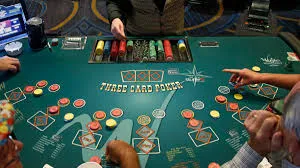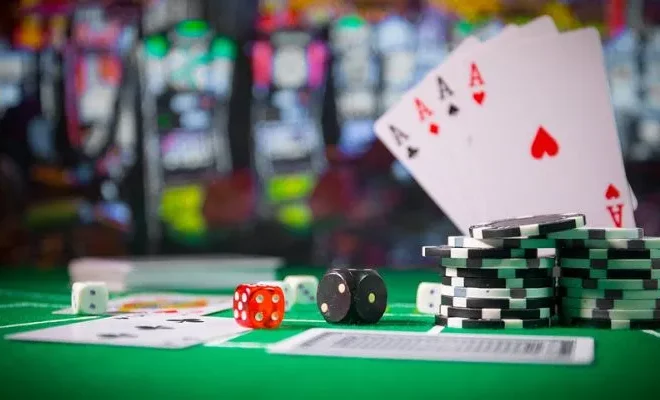
10 Things You Should Know About Native American Casinos
Native American casinos have become a popular destination for gamblers all over the world. With their unique cultural and historical background, these casinos offer not only a chance to win big but also a glimpse into the rich traditions of Native American tribes. However, there are many aspects of these casinos that are often misunderstood or unknown to the general public.
In this article, we will take an in-depth look at 10 things you should know about Native American casinos. From their history and significance to their impact on the economy and local communities, we will cover all the important aspects of these establishments. So let’s dive in and gain a better understanding of these fascinating casinos.
Outline:

- The History of Native American Casinos
- The Legal Framework of Native American Casinos
- The Impact of Native American Casinos on the Economy
- The Relationship between Native American Tribes and Casinos
- The Unique Features of Native American Casinos
- The Controversies Surrounding Native American Casinos
- Conclusion
1. The History of Native American Casinos
Native American casinos have a long and fascinating history that dates back to the pre-colonial era. Before the arrival of European settlers, gambling was an integral part of Native American culture. Many tribes had their own traditional games that were played for entertainment and sometimes even for spiritual purposes.
However, with the arrival of Europeans, gambling took on a different form. In the late 19th and early 20th centuries, Native Americans were forced off their land and onto reservations. These reservations were often remote and isolated, making it difficult for tribes to make a living. This led to the creation of small-scale gambling operations on reservations, such as bingo halls and card rooms, to generate income.
But it wasn’t until 1988 that the landscape of Native American gaming changed dramatically. That year, the Indian Gaming Regulatory Act (IGRA) was passed by Congress, giving Native American tribes the ability to operate casinos on their reservations. This legislation opened the door for a new era of Native American gaming and set the stage for the development of large-scale casinos we see today.
The Birth of the First Native American Casino
The first Native American casino to open its doors under the IGRA was the Seminole Tribe of Florida’s High Stakes Bingo in 1988. This small bingo hall, located on the Hollywood Reservation, offered high-stakes games that quickly became popular with gamblers from all over the state. This success caught the attention of other tribes, and soon, more and more Native American casinos were opening across the United States.
One of the key elements that led to the success of these early casinos was their location. Many of these reservations were situated near major cities, making them easily accessible to a large population. This gave Native American casinos an advantage over their non-native competitors, who often had to deal with restrictive state laws.
Another factor that played a crucial role in the growth of Native American gaming was the revenue-sharing agreements between tribes and the government. Under the IGRA, tribes were required to use a portion of their gaming revenue to fund education, health care, and other services for their communities. This not only improved the standard of living on reservations but also helped to build stronger relationships between tribes and local governments.
Rise of Mega Casinos
As more and more tribes entered into the gaming industry, competition among Native American casinos intensified. To attract more customers and boost revenues, many tribes began investing in larger, more extravagant casinos. These mega casinos offered a wide range of gaming options, including slot machines, poker, blackjack, and roulette, and often featured luxurious hotels, restaurants, and entertainment venues.
One of the most successful and well-known Native American casinos is the Foxwoods Resort Casino in Connecticut. Opened in 1992 by the Mashantucket Pequot Tribal Nation, Foxwoods was one of the first casinos to offer Las Vegas-style gaming on a reservation. With more than 9 million square feet of space and over 6,500 slot machines, it quickly became one of the largest casinos in the world.
With the success of Foxwoods, many other tribes followed suit, building their own mega casinos. This trend not only provided economic benefits for tribes but also created thousands of jobs for their members and surrounding communities.
2. The Legal Framework of Native American Casinos

Native American casinos operate under a unique legal framework that is different from commercial casinos. As mentioned earlier, the IGRA is the primary legislation that governs Native American gaming.
The Indian Gaming Regulatory Act (IGRA)
The IGRA was passed by Congress in 1988 with the aim of creating a regulatory structure for Native American gaming. It established three classes of gaming, each with its own set of regulations:
- Class I: Includes traditional and social games played for minimal prizes. These games are regulated by tribes and do not require approval from the government.
- Class II: Includes bingo, pull-tabs, and non-banked card games. These games are regulated by tribes but must adhere to certain federal regulations.
- Class III: Includes all other forms of gaming, such as slot machines, poker, and blackjack. These games require a compact between the tribe and the state in which the casino is located.
Under the IGRA, tribes can only operate Class II and Class III games, and they must negotiate a compact with the state before offering these types of gaming. The compact outlines the terms and conditions for the operation of the casino, including revenue sharing agreements and regulatory oversight.
The Role of the National Indian Gaming Commission (NIGC)
The NIGC was created as a result of the IGRA and is responsible for regulating and overseeing Native American gaming. This agency is responsible for ensuring that all casinos comply with federal regulations and that tribes are fairly compensated for their gaming activities.
The NIGC has the authority to investigate and enforce compliance with the IGRA, and it has the power to impose fines and even shut down casinos that fail to adhere to the law. It also works closely with tribal gaming regulators to ensure the integrity and fairness of games and prevent any criminal activity.
3. The Impact of Native American Casinos on the Economy
Native American casinos have had a significant impact on the economy, both at the local and national levels. According to the National Indian Gaming Association (NIGA), tribal gaming generated $33.7 billion in economic output in 2019, supporting over 635,000 jobs and paying over $18.6 billion in taxes and revenue sharing payments.
Employment Opportunities
One of the biggest benefits of Native American casinos is the employment opportunities they provide for tribal members and nearby communities. Many of these casinos are located in areas with high unemployment rates, and the jobs they create can provide a much-needed source of income for local residents.
In addition to direct employment at the casino, tribal gaming has also led to the growth of other businesses and industries, such as hotels, restaurants, and retail stores. This has created even more job opportunities and helped to boost the overall economy of the region.
Revenue Sharing with Local Communities
As part of their compacts with states, tribes are required to share a portion of their gaming revenue with local communities. These payments are used to fund public services and programs such as education, healthcare, infrastructure, and law enforcement.
For example, in California, where there are over 70 Native American casinos, tribes pay a percentage of their gaming revenue to non-gaming tribes and local governments. This has had a significant impact on the state’s economy, with tribes contributing over $9 billion in revenue sharing payments since 2000.
Economic Development on Reservations
Native American casinos have also brought much-needed development and infrastructure to reservations. With their increased revenues, many tribes have been able to invest in projects that benefit their communities, such as building schools, hospitals, and community centers.
Moreover, the success of these casinos has allowed tribes to diversify their economies beyond gaming. For example, some tribes have used their gaming profits to invest in renewable energy projects, creating jobs and reducing dependence on external sources of income.
4. The Relationship between Native American Tribes and Casinos

One of the unique aspects of Native American casinos is the relationship between tribes and their casinos. Unlike commercial casinos, which are often owned by large corporations, Native American casinos are owned and operated by tribal governments. This creates a strong bond between the tribe and its casino, based on mutual interests and goals.
Sovereignty and Self-Governance
The relationship between tribes and casinos is rooted in the concept of tribal sovereignty. Native American tribes are considered sovereign nations within the United States and have the right to self-govern. This means that they can establish their own laws, regulations, and judicial systems without interference from the federal or state government.
This sovereignty extends to their gaming operations, allowing tribes to regulate and operate casinos on their land without outside interference. However, this does not mean that Native American casinos are completely exempt from federal laws. They must still adhere to certain regulations set by the NIGC and comply with the provisions of the IGRA.
The Importance of Tribal Gaming to Communities
For many Native American tribes, gaming has become a vital source of revenue and economic development. Revenue generated by casinos is often used to fund essential services for tribal members, such as healthcare, housing, and education. It has also helped to preserve and revitalize tribal cultures and traditions, which were once on the brink of extinction.
Moreover, the success of Native American casinos has allowed tribes to become more self-sufficient, reducing their dependence on federal government funding. This has given them greater control over their own affairs and enabled them to shape their own future as sovereign nations.
5. The Unique Features of Native American Casinos
Native American casinos offer a one-of-a-kind gaming experience that sets them apart from their commercial counterparts. From their design and décor to the games they offer, these casinos showcase the rich cultural history of Native American tribes.
Tribal Design Elements
Many Native American casinos incorporate traditional tribal design elements into their architecture and interior décor. These can include symbols and motifs from the tribe’s culture, such as totem poles, dream catchers, and traditional artwork. Some casinos even feature replicas of historical structures or landmarks significant to the tribe.
The use of natural materials is also common in Native American casinos, with many incorporating wood, stone, and other natural elements into their design. This not only adds to the casino’s aesthetic appeal but also pays homage to the tribe’s connection to the land.
Traditional Games and Ceremonies
As mentioned earlier, Native American casinos often feature traditional games that have been played by tribes for centuries. These games are more than just a form of entertainment; they hold great cultural significance and are an important part of tribal ceremonies and rituals.
Some Native American casinos also incorporate traditional ceremonies into their operations, such as smudging, drumming, and dancing. These ceremonies not only provide a unique experience for visitors but also serve to educate them about the tribe’s culture and traditions.
Indigenous Cuisine
Another way Native American casinos celebrate their heritage is through their food offerings. Many casinos feature indigenous cuisine on their menus, providing visitors with an opportunity to try dishes that have been passed down through generations.
This not only showcases the tribe’s culinary traditions but also supports and promotes their local agriculture and food producers. It also adds to the overall cultural experience for visitors, allowing them to sample new and unique flavors.
6. The Controversies Surrounding Native American Casinos

Like any other industry, Native American gaming has faced its fair share of controversies and challenges over the years. Here are some of the most significant issues that have surrounded these casinos.
Opposition from Non-Native Gaming Interests
One of the main sources of controversy surrounding Native American casinos is the opposition they face from non-native gaming interests. Commercial casinos and other forms of gambling, such as lotteries and horse racing, see tribal gaming as a threat to their profits and have lobbied against it.
This has led to legal battles between tribes and commercial gaming interests, with some non-native groups attempting to block or limit tribal gaming through lawsuits and political pressure. However, tribes have been able to overcome these challenges by working together and with government agencies to defend their right to self-governance and economic development.
Issues with Revenue Sharing Agreements
As mentioned earlier, tribes are required to share a portion of their gaming revenue with local communities under their compacts with states. However, there have been instances where these agreements have been challenged or renegotiated, causing tension between tribes and local governments.
In some cases, tribes have objected to sharing their revenue with non-gaming tribes, arguing that they should only be responsible for supporting their own communities. This has led to disputes and lawsuits between tribes, which could potentially strain the relationships between them.
Concerns about Addiction and Crime
Another common criticism of Native American casinos is that they contribute to addiction and crime in surrounding communities. While addiction can be a problem in any form of gambling, including commercial casinos, some studies have shown higher rates of problem gambling among Native Americans.
Moreover, there have been concerns that the proximity of Native American casinos to urban areas could lead to an increase in crime rates. However, a study conducted by the National Institute of Justice found that there was no significant difference in crime rates between counties with and without Native American casinos.
Conclusion
Native American casinos have come a long way since their humble beginnings as small bingo halls on reservations. Today, these casinos play a crucial role in the economy, not only for tribes but also for surrounding communities. They have provided much-needed revenue, employment opportunities, and economic development in areas where these resources were once scarce.
However, Native American casinos are more than just gaming establishments; they are a reflection of the rich cultural heritage and traditions of Native American tribes. By incorporating traditional elements into their design and operations, these casinos provide visitors with a unique and immersive experience that is not found anywhere else.
But like any other industry, Native American gaming has faced its share of controversies and challenges. Despite these issues, however, the success of these casinos stands as a testament to the resilience and determination of Native American tribes to preserve their sovereignty and promote economic independence.


